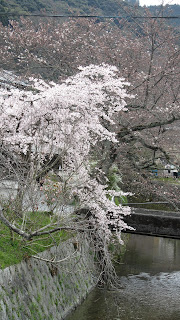 We have arrived in Japan just as the cherry blossoms are coming out. And
they are stunning in their beauty. Their flowers literally take over their cherry-trees
(called "sakura").The Japanese hold flower-viewing parties (Hanami), in which large numbers of people arrive at parks, shrines, and
temples with family and friends to enjoy a spring break.
We have arrived in Japan just as the cherry blossoms are coming out. And
they are stunning in their beauty. Their flowers literally take over their cherry-trees
(called "sakura").The Japanese hold flower-viewing parties (Hanami), in which large numbers of people arrive at parks, shrines, and
temples with family and friends to enjoy a spring break.
In Japan, while the cherry
blossoms can represent innocence, simplicity and spring, they have a long standing symbolic value: In the past, the samurai culture admired
the flower since samurais (like the cherry blossom) were considered to have a relatively
short life expectancy… and also because they believed the flower represented
drops of blood.
 For many, the transience of the
blossoms - their extreme beauty and quick death - is embodied in the concept of
mono
no aware (もののあはれ?). [1]
Mono no aware - literally "the pathos of things" - is a
Japanese term for the awareness of impermanence
(無常 mujō?), or transience of
things, and a gentle sadness at their passing.
For many, the transience of the
blossoms - their extreme beauty and quick death - is embodied in the concept of
mono
no aware (もののあはれ?). [1]
Mono no aware - literally "the pathos of things" - is a
Japanese term for the awareness of impermanence
(無常 mujō?), or transience of
things, and a gentle sadness at their passing.
For us as visitors, we have
loved the flowers, and have enjoyed the wonderment of the people as they emerge
from their winter into spring.
[1] The association of the cherry blossom with
mono no aware dates back to 18th-century scholar Motoori
Norinaga.]





No comments:
Post a Comment